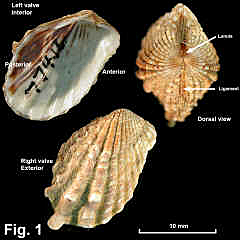|
|
CARDITIDAE CARDITINAE |
|
|
Click on an image to enlarge
|
Cardita aviculina Lamarck, 1819 Description: Shape shell moderately inflated, elongate, extended posteroventrally, umbones prominent; lunule small, deep, in front of umbo. Exterior with about 15 scaly radial ribs, middle ones stronger. Interior with exterior ribs showing through; anterior and posterior muscle scars present, pallial line continuous but usually poorly defined. Hinge strong; left valve with 2 cardinals with socket between, and long, slender blade-shaped lateral; right valve with single nodular cardinal and long, slender slotted lateral. Ligament external, moderately long. Shell colour fawn, red-brown or pink, sometimes yellow between ribs. Interior colour usually white, often with black patches, or completely black, or with black stripes. Size: Up to 30 mm in length. Distribution: Endemic to Australia: Southern Australia, from Caloundra, Qld, to North-West Cape, WA, including Tas. Habitat: Under stones on rocky shores, low tide and below, attached by byssus. Common in beach washup. Comparison: Cardita crassicosta Lamarck, 1819 is a similar but larger species, up to 75 mm in size. It is an Indo-West Pacific species, occurring in northern Australia. It has a documented distribution of northern Australia, extending down the entire west coast of Western Australia, and then eastwards along the southern coast to South Australia. It was also reported from Victoria by Macpherson & Gabriel (1962) – probably as a vagrant. On the east coast, the Australian Museum holds specimens as far south as Hervey Bay, Qld. However, there are no reports of the species from NSW. Synonymy: This has been known in NSW literature as Cardita excavata Deshayes, 1854 but Lamarck’s name is earlier and hence it must be used. Another name used has been Cardita citrina Lamarck, 1819. Cardita tasmanica (Tenison-Woods, 1876) has been used in Tasmania, and was also used by Cotton (1961) for South Australian shells. In Victoria, Macpherson & Gabriel (1962) used Cardita calyculata (Linnaeus, 1758), which is now regarded as a North Atlantic and Mediterranean Sea species. Fig. 1: Long Reef, Collaroy, NSW (C.77416)
|
|
